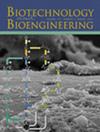还原剂和辅底物在热thielavioides terrestris AA9E与纤维素结合过程中的作用
IF 3.6
2区 生物学
Q2 BIOTECHNOLOGY & APPLIED MICROBIOLOGY
引用次数: 0
摘要
纤维素活性水解多糖单加氧酶(LPMO)通过攻击纤维素的有序区域促进植物细胞壁的解构。在体外,还原剂(如抗坏血酸)将LPMOs还原为Cu(I)-LPMO,过氧化氢(H2O2)作为纤维素糖苷键氧化裂解的共底物。利用全内反射荧光显微镜的超分辨率单分子成像技术,观察和列举了荧光标记的Thermothielavioides terrestris AA9E (TtAA9E)在清除氧缓冲体系中与高度有序的纤维素原纤维的结合事件。在葡萄糖氧化酶/过氧化氢酶(GODCAT)系统中,氧被转化为H2O2,然后被过氧化氢酶除去。在GODCAT体系中加入抗坏血酸促进了TtAA9E与纤维素的快速结合。相比之下,在原儿茶酸/原儿茶酸3,4-双加氧酶(PCA/PCD)氧清除系统中缺乏氧气和H2O2,添加抗坏血酸几乎消除了TtAA9E对纤维素的结合。我们的研究结果表明,在GODCAT系统中,TtAA9Es被抗坏血酸还原,并被H2O2激活,促进与纤维素的结合。在PCA/PCD体系中,由于缺乏H2O2,还原的ttaa9e不能被激活,这表明在没有H2O2的情况下,还原的Cu(I)-TtAA9E不能与纤维素结合。值得注意的是,在含有抗坏血酸的PCA/PCD体系中,氧化糖的释放最初滞后,但在更长的反应时间内观察到,这表明H2O2可能是氧气被吸收到溶液中时原位产生的限制性反应物。LPMO与纤维素的结合时间与实验条件无关:(82%±6%)的LPMO与纤维素结合的酶停留时间为14±2.5 s,而16%±5%的结合酶停留时间为60±9 s。本文章由计算机程序翻译,如有差异,请以英文原文为准。
Investigation Into the Role of Reductants and Cosubstrates in Lytic Polysaccharide Monooxygenase Thermothielavioides terrestris AA9E Binding to Cellulose by Single-Molecule Imaging.
Cellulose-active Lytic Polysaccharide Monooxygenases (LPMO) facilitate plant cell wall deconstruction by attacking ordered regions of cellulose. In vitro, reductants (e.g., ascorbic acid) reduce LPMOs to Cu(I)-LPMO, and hydrogen peroxide (H2O2) serves as co-substrate for oxidative cleavage of cellulose glycosidic bonds. Super-resolution single-molecule imaging by total internal reflection fluorescence microscopy was used to visualize and enumerate binding events of fluorescently-labeled Thermothielavioides terrestris AA9E (TtAA9E) on highly ordered cellulose fibrils in oxygen-scavenging buffer systems. In the glucose oxidase/catalase (GODCAT) system, oxygen is converted to H2O2, then removed by catalase. Adding ascorbic acid to the GODCAT system promoted rapid binding to cellulose by TtAA9E. In contrast, absent both oxygen and H2O2 in the protocatechuic acid/protocatechuate 3,4-dioxygenase (PCA/PCD) oxygen-scavenging system, adding ascorbic acid nearly eliminated cellulose binding by TtAA9E. Our results suggest that in the GODCAT system, TtAA9Es are reduced by ascorbic acid and activated by H2O2, facilitating binding to cellulose. In the PCA/PCD system, reduced TtAA9Es are not activated due to the lack of H2O2, suggesting that reduced Cu(I)-TtAA9E cannot bind to cellulose without H2O2. Notably, in the PCA/PCD system with ascorbic acid, oxidized sugar release initially lagged but was observed at longer reaction times, suggesting that H2O2 could be a limiting reactant generated in situ as oxygen becomes absorbed into solution. Binding durations of LPMO to cellulose were independent of experimental conditions: ( 82% ± 6%) of cellulose-bound LPMOs resided briefly for 14 ± 2.5 s, while 16% ± 5% of the bound enzymes remained for 60 ± 9 s.
求助全文
通过发布文献求助,成功后即可免费获取论文全文。
去求助
来源期刊

Biotechnology and Bioengineering
工程技术-生物工程与应用微生物
CiteScore
7.90
自引率
5.30%
发文量
280
审稿时长
2.1 months
期刊介绍:
Biotechnology & Bioengineering publishes Perspectives, Articles, Reviews, Mini-Reviews, and Communications to the Editor that embrace all aspects of biotechnology. These include:
-Enzyme systems and their applications, including enzyme reactors, purification, and applied aspects of protein engineering
-Animal-cell biotechnology, including media development
-Applied aspects of cellular physiology, metabolism, and energetics
-Biocatalysis and applied enzymology, including enzyme reactors, protein engineering, and nanobiotechnology
-Biothermodynamics
-Biofuels, including biomass and renewable resource engineering
-Biomaterials, including delivery systems and materials for tissue engineering
-Bioprocess engineering, including kinetics and modeling of biological systems, transport phenomena in bioreactors, bioreactor design, monitoring, and control
-Biosensors and instrumentation
-Computational and systems biology, including bioinformatics and genomic/proteomic studies
-Environmental biotechnology, including biofilms, algal systems, and bioremediation
-Metabolic and cellular engineering
-Plant-cell biotechnology
-Spectroscopic and other analytical techniques for biotechnological applications
-Synthetic biology
-Tissue engineering, stem-cell bioengineering, regenerative medicine, gene therapy and delivery systems
The editors will consider papers for publication based on novelty, their immediate or future impact on biotechnological processes, and their contribution to the advancement of biochemical engineering science. Submission of papers dealing with routine aspects of bioprocessing, description of established equipment, and routine applications of established methodologies (e.g., control strategies, modeling, experimental methods) is discouraged. Theoretical papers will be judged based on the novelty of the approach and their potential impact, or on their novel capability to predict and elucidate experimental observations.
 求助内容:
求助内容: 应助结果提醒方式:
应助结果提醒方式:


